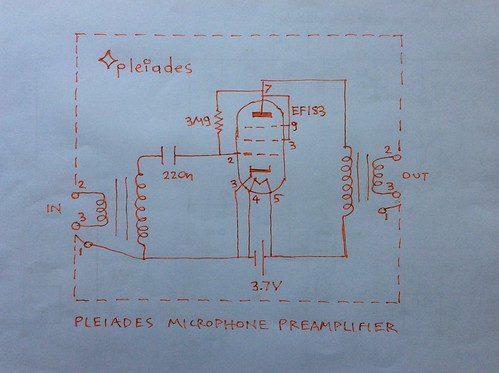The grid finds itself to value at a specific cathode temperature. (Very easy to verify by connecting a voltmeter between cathode and grid. Then applying heater voltage. (Always use a fuse in series with psi or battery for safety)). We can steer this self assumed voltage to where we want by applying Pleiades grid bias.
For example on the Pleiades V6 circuit using a Nuvistor 7586 electron tube and 6MΩ Pleiades bias anode to grid resistor:

Before connecting the heaters as expected the grid to cathode potential is about 2.5V. In fact this is not true it should be more. The voltmeter having an input impedance of 10MΩ for,s a potential devider. The supply voltage is dropped across the 6MΩ as the voltmeter draws current to make the measurement.
When heater voltage is applied things are better. The grid to cathode generated potential by the emmited electrons is much more low impedance.
So when heaters are connected to 3.9V the grid bias drops (in fact cathode becomes positive by the missing electrons) until it stabilizes at about -77mV.
So -77mV is the grid bias (the grid potential with respect to cathode) of the Pleiades V6 circuit at these conditions with a Nuvistor 7586 electron tube.
If a few ohm series resitor is connected in the heater circuit (ie further lowering the cathode temperature) the grid bias becomes -29mV.
When no Pleiades bias resistor is connected and nothing else ttomthe electron tube except the voltmeter from grid to cathode the grid bias is about -700mV by the missing electrons from the cathode. So the electron tube does not operate at a small anode voltage.
At -77mV with the Pleiades bias of the 6MΩ resistor from anode to grid it is walk in the park. The let grin tube operates normally and in a low noise way with just 3.9V at the anode or plate.
Same for the case of -29mV.
On all of these conditions the anode current is 25μA.
Why? Could it be that Pleiades self bias helps achieving space charge conditions? If this the case shot noise, even grid shot noise is reduced?
By using Ohm's law to calculate how much current flows through the Pleiades bias anode to grid resistor we have roughly 4V/6MΩ=(2/3)μA
Further reading::
On preserving electron tube transconuctance at an anode potential as low as 3V - euroelectron
Operating Features of the Audion - E. H. Armstrong
Communication Engineering - Everitt - Ch. XV, Class A Amplifiers
No comments:
Post a Comment